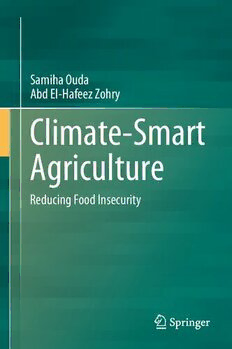
Climate-Smart Agriculture: Reducing Food Insecurity PDF
Preview Climate-Smart Agriculture: Reducing Food Insecurity
Samiha Ouda Abd El-Hafeez Zohry Climate-Smart Agriculture Reducing Food Insecurity Climate-Smart Agriculture · Samiha Ouda Abd El-Hafeez Zohry Climate-Smart Agriculture Reducing Food Insecurity SamihaOuda AbdEl-HafeezZohry WaterRequirementsandFieldIrrigation CropsInteseficationResearchDepartment ResearchDepartment FieldCropsResearchInstitute;Agricultural Soils,WaterandEnvironmentResearch ResearchCenter Institute;AgriculturalResearchCenter Giza,Egypt Giza,Egypt ISBN978-3-030-93110-0 ISBN978-3-030-93111-7 (eBook) https://doi.org/10.1007/978-3-030-93111-7 ©TheEditor(s)(ifapplicable)andTheAuthor(s),underexclusivelicensetoSpringerNature SwitzerlandAG2022 Thisworkissubjecttocopyright.AllrightsaresolelyandexclusivelylicensedbythePublisher,whether thewholeorpartofthematerialisconcerned,specificallytherightsoftranslation,reprinting,reuse ofillustrations,recitation,broadcasting,reproductiononmicrofilmsorinanyotherphysicalway,and transmissionorinformationstorageandretrieval,electronicadaptation,computersoftware,orbysimilar ordissimilarmethodologynowknownorhereafterdeveloped. Theuseofgeneraldescriptivenames,registerednames,trademarks,servicemarks,etc.inthispublication doesnotimply,evenintheabsenceofaspecificstatement,thatsuchnamesareexemptfromtherelevant protectivelawsandregulationsandthereforefreeforgeneraluse. Thepublisher,theauthorsandtheeditorsaresafetoassumethattheadviceandinformationinthisbook arebelievedtobetrueandaccurateatthedateofpublication.Neitherthepublishernortheauthorsor theeditorsgiveawarranty,expressedorimplied,withrespecttothematerialcontainedhereinorforany errorsoromissionsthatmayhavebeenmade.Thepublisherremainsneutralwithregardtojurisdictional claimsinpublishedmapsandinstitutionalaffiliations. ThisSpringerimprintispublishedbytheregisteredcompanySpringerNatureSwitzerlandAG Theregisteredcompanyaddressis:Gewerbestrasse11,6330Cham,Switzerland ToOurParents MayAllahHaveMercyonTheirSouls ToOurChildrenandGrandchildren MayAllahBlessThemwithBrightFuture andHappiness Preface In2015, theUNGeneral Assemblyreleased what isknown as ‘Transforming Our World:The2030AgendaforSustainableDevelopment’.TheAgendahas17Sustain- able Development Goals (SDGs), 169 targets demonstrate the scale, and ambition of this new universal Agenda to be a plan of action for people, planet, and pros- perity. The agenda integrated and attain the balance between the three dimensions ofsustainabledevelopment:economic,social,andenvironmental. Amongthe17SDGs,Goal2seekstoendhungerandensureaccessbyallpeople, in particular, the poor and people in vulnerable situations, to safe nutritious and sufficient food all year round by the year 2030. Target 4 of that goal seeks to ensuresustainablefoodproductionsystemsandimplementresilientagriculturalprac- tices that increase productivity and production. It ensure helping maintain ecosys- tems that strengthen capacity for adaptation to climate change, extreme weather, drought, flooding, and other disasters, which progressively improve land and soil quality.However,moresevereandfrequentextremeweathereventsarecausinghigh uncertaintyinaccomplishingthisgoal. The FAO organization produced the concept of climate-smart agriculture to achievetheabovetarget,withemphasisontheeffectofclimatechange.Theconcept ofclimate-smartagriculturehasfascinateduswithitscollectivepracticesthatcould attainbetterwelfaretoruralcommunitiesindevelopingcountries.Thus,wedecided to write this book to elaborate on the concept of climate-smart agriculture and classify some of the practices done in Egypt according to its pillars. Furthermore, we suggested other management practices that can be easily done in a developing countriestoimprovefoodsecurityconditions. InPartIofthebook,wewilldiscussthefirstpillarofclimate-smartagriculture, namelysustainablyincreasesagriculturalproduction.Thispartconsistsoffourchap- terstocovertherelatedsubjectstothesustainableuseofnaturalresourcestoincrease foodproduction.TheChap.1willdiscusstheconceptofwater-smartpracticesand how it could be used to manage water scarcity in Egypt. The Chap. 2 will present oneofthesuccessfulpracticestodealwithwaterscarcity,namelyusingfishfarms effluents for irrigation in a field and modeling studies. The Chap. 3 will tickle the ideaofsoil-smartpracticesthroughtheintegratedsoilfertilitymanagement.Lastly, vii viii Preface the Chap. 4 will discuss the integration of crop-smart, water-smart, and soil-smart practicestosustainablyincreasefoodsecurity. Part II of this book will discuss the second pillar of climate-smart agriculture, namelybuildresiliencetoclimate,whichwillincludethreechapters.TheChap.1 willdiscussthemosteffectiveinfluencerincropproduction,namelyclimateextremes andthesuggestedmeasurestothestressofclimatevariabilityinEgypt.Thefollowing chapterwillassesstheeffectofclimatevariabilityonwheatproductivityinEgypt. The last chapter in this part will review several climate-resilient crops cultivated aroundtheworldandinEgypt. In Part III, the third pillar, namely reduction of the greenhouse gases from the cultivated area will be discussed in one chapter which will review practices that contributetothereductionoftheemissionofgreenhousegases. We hope that this book will assist researchers in other developing countries in theirsensiblequesttoimprovetheirfoodsecuritysituationandattainabetterlifefor theircitizens. Giza,Egypt SamihaOuda 2021 Introduction Tremendous pressure, largely exists, on the use of natural resources due to rising population, urbanization, environmental stresses, and climate change. Agriculture productionsystemrequiresresilientdevelopmentpathwaystoaugmentglobalfood grainproduction,reducegreenhousegasesemissionsfromagriculturalactivityand adapt agriculture to climate change and variability (Lipper et al. 2014). The Food and Agriculture Organization (FAO) of the United Nations has reported that food production needs to be increased by at least 60% to meet the needs of the world’s expectedpopulationof9billionby2050(FAO2014).Thiswillbeagreatchallenge forglobalagricultureundertheconditionofclimatevariabilityresultedfromclimate change. Additionally, shifting weather patterns, including risingtemperatures, and unpredictableprecipitationcanhavenegativeeffectsoncropsyield,andagricultural production. Weatherisanimportantdeterminantoftheproductivityofthecultivatedcrops. Temperatureandrainfallaffectthedevelopmentofplants,eitheraloneorbyinter- acting with other factors (IPCC 2007). The World Meteorological Organization (2012) stated that weather reflects short-term conditions of the atmosphere, while climateistheaveragedailyweatherforanextendedperiodoftimeatacertainlocation overmanyyears(usuallyatleast30years).Theuncertaintyassociatedwithweather patternsisoneofthegreatestcontributorstothegappresentbetweenpotentialand actual yield (Zhang et al. 2013). Lobell et al. (2009) estimated the gap between potentialandactualyieldby20%inmanycases.Climatevariabilityisoftenusedto describeanykindofchangeinclimatethatmaybenaturalorhuman-induced(Hegerl etal.2007).Ofori-Sarpong(2011)indicatedthatrisingtemperatures,unpredictable rainfall, loss of soil moisture, and increased evaporation and transpiration are the factorsofclimatevariability. ix x Introduction ExtremeWeatherEvents IPCC (2011) defines the extreme weather events caused by climate variability “as rareasorrarerthanthe10thor90thpercentileofaprobabilitydensityfunctionesti- matedfromobservations”.Extremeeventsareexpectedtocauseinstabilityofcrops yieldsandforminghighrisktoglobalcropproduction(Lobelletal.2013).Research ontheeffectsofextremeweathereventsonmajorcropsworldwidewasemployed. Schlenker and Roberts (2009) indicated that extremely high daytime temperatures are destructive and could be lethal to crops. Drought leads to stomata closure and photosynthesis reduction, which negatively affects the yield (Chaves et al. 2010). Rosenzweigetal.(2001)reportedthathighertemperaturesthanthresholdtempera- turesmayleadtosignificantreductionsincropyields.Physiologicalprocessesofa cropcouldbeaffectedbyextremeweathereventscausingphysicaldamage(vander Veldeetal.2012).Accelerationinphenologicaldevelopmentofcropsunderwarmer conditionsisobserved,whichreducesgrowingseason,reducesnetphotosynthesis, and consequently reduces yield (Lobell and Ortiz-Monasterio 2007). Other indi- recteffectscouldoccur,suchasinfluencesonsoilprocessesandnutrientdynamics. Moreover,insect,pest,andplantdiseasesmaymagnifyunderexposuretoextreme weatherevents(Motha2011). Yield losses higher than 30% in fruit and vegetable crops were found due to droughtconditionsin2016intheNortheasternUnitedStatesreported(Sweetetal. 2017). It was reported that photosynthesis rates of sweet corn were decreased by 30% when the temperature exceeded 30 °C (Ben-Asher et al. 2008). Moreover, the interaction between high temperature and drought stress reduced both wheat photosynthesis and yield (Shah and Paulsen 2003). Powell and Reinhard (2016) found that high temperature and precipitation events are time specific, where its effectonyieldsisvariedbasedongrowthstagesofwheat. Egyptian agriculture has faced serious risks from climate variability causing significantnegative impactsontheyieldofmajorcropsandconsequentlyonfood security. It was reported that in 1998 growing season, rice plants were exposed to heatwave during flowering and grain filling stages causing a reduction in national riceproduction(KhalilandHassanein2016).Mahmoodetal.(2010)indicatedthat exposing rice plants to heatwave during the flowering growth stage could cause sterility, whereas during the grain filling stage, it reduces grain weight and grain number.Theyalsoreportedthatadeclineingrainnumberisdirectlyproportionalto increasingtemperature. Wheatproductionwasalsoreducedin2010,asaresultofheatwaveprevailedin thatyearbyanaverageof15%overEgypt(Salehetal.2017).Taha(2012)reported losses in wheat productivity in 2010. With respect to maize, Saleh et al. (2017) indicated that maize production was reduced by an average of 11% in 2015 as a resultofheatwavethatoccurredinthatyear,comparedtoitsproductionin2010. Introduction xi ClimateChangeEffects Agriculturalproductionisaffectedbyclimatechangeindirectandindirectpathways. Theincreaseinmeantemperaturesacceleratesdirectlycropdevelopment,thechange inseasonalprecipitationamountstogetherwithincreasingevaporativedemandcan indirectlyleadtomoredroughtstressforcrops(IPCC2012).Martinsetal.(2019) indicatedthatincreasedtemperaturesarelikelytoshortenthecropcycleasaresultof accelerationincropdevelopmentandphenologicalstages(EyshiRezaeietal.2018), thus reducing crop production. On the other hand, alteration of precipitation will affectwateravailabilityforcrops,sothatcropyieldwillbeseverelyaffectedoreven cropfailurecouldoccur(Assengetal.2013).Thus,globalclimatechangeadversely impacts crop production and imposes a wide range of constraints on agricultural systems,especiallyinwater-limitedenvironments(Paymardetal.2018). Climate-SmartAgriculture Thedeteriorationinthenaturalresourcesworldwide,asaresultofthecontinualuse of the same technologies necessitates the use of sustainable practices to enable to producefoodforthegrowingpopulationandtomitigatetheeffectsofclimatechange. Climate-smartagriculturecouldbetheapproachtobeusedtoavoidthedeteriora- tionofnaturalresources.Climate-smartapproachwasintroducedbyFAO(2010)as an integrated approach that aims at sustainably increases agricultural productivity andincomes,buildresiliencetoclimate,andreduceemissionsofgreenhousegases. Therefore,itputemphasisontheneedforchangingtheprevailingmanagementprac- ticesinagricultureincludingwaterandsoilstoensureitsefficientandsustainableuse toproducemorefood,adapttoclimatechange,andreduceemissionsofgreenhouse (FAO2013).Climate-smartagriculturehasalsobeenidentifiedasanapproachfor transformingandreorientingagriculturalsystemstosupportfoodsecurityunderthe newrealitiesofclimatechange(Lipperetal.2014).Climate-smartagriculturehas alsobeenknownas“triplewin”,whichsimultaneouslyachievesitsthreeobjectives (orpillars):foodsecurity,mitigation,andadaptation(Fallot2016).Itcallsforaset of actions by decision-makers from farm to global level, to enhance the resilience ofagriculturalsystemsandlivelihoodsandreducetheriskoffoodinsecurityinthe present,aswellasinthefuture(Lipperetal.2014).Thethreepillarsofclimate-smart practicescanbestatedasfollows: SustainablyIncreasesAgriculturalProduction Climate-smartpracticescanattainhigherproductiontofeedthegrowingpopulation andincreasefoodavailabilityandsecurity.Itwasreportedthatusingsustainablefarm
